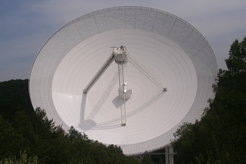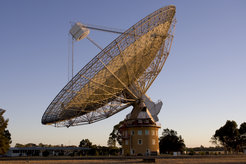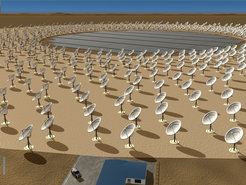Strengthening the German-Australian Connection in Radio Astronomy
Scientific cooperation agreement signed between the leading radio astronomy institutes in both countries


The major radio astronomical facilities in the Northern and the Southern Hemispheres, respectively, the MPIfR's 100m Effelsberg antenna and the ATNF's 64m Parkes dish. The whole radio skies can be covered combining both telescopes at the highest sensitivities.
The German Max Planck Society, represented by the Max Planck Institute for Radio Astronomy (MPIfR), and the Australian Commonwealth Scientific and Industrial Research Organisation (CSIRO), represented by its Australia Telescope National Facility (ATNF) have agreed upon an agreement to cooperate in the development of new instrumentation for radio astronomy and to strenghten further the scientific cooperation between astronomers in both countries. This agreement has been signed by Prof. Anton Zensus and Prof. Karl Menten, both directors at the MPIfR and Prof. Bryan Boyle, director at the ATNF. It coincides in time with the visit of the Australia's Minister for Innovation, Industry, Science and Research, Senator Kim Carr to his homologous, the German Federal Minister for Education and Research, Dr. Annette Schavan.
Both institutes, ATNF and MPIfR, are involved in the global Square Kilometre Array (SKA) program and its pathfinder programs (the Australian SKA Pathfinder (ASKAP) and the eLOFAR telescope stations in Germany). The SKA (Figure 2) will be a set of thousands of antennas, not a single giant instrument, spread over 3000 kilometres, but with half of the antennas located in a central region 5 kilometres across. Australia is one of the two possible location sites for the SKA, which final location will be defined by an international commission in a near future. The SKA will be 50 times more sensitive than the most powerful radio telescopes we now have, opening a new window to the universe, from the first stars and galaxies to the magnetic fields in the nearby and far galaxies, including studies of the dark energy driving our Universe at an ever increasing speed.
"We have common interests in a number of issues. Technological developments paving the way to the SKA will be a breakthrough for the investigation of the universe and the development of radio astronomy", says Prof. Anton Zensus, chairman of the European SKA Consortium.

The scientific collaboration in radio astronomy between Germany and Australia touches several areas of modern astrophysics. Particularly intense common research is conducted in the areas of star formation and astrochemistry (group of Prof. Karl Menten) as well as physical processes in active galaxies (group of Prof. Anton Zensus). MPIfR and ATNF operate a top range of radio telescopes including Effelsberg and IRAM in Europe, APEX in Chile, and Parkes and ATCA in Australia.
Following the new agreement, long term cooperation is strengthened in fields like the development of a state-of-the-art short wavelength receivers for Effelsberg, investigation of magnetic fields in the Universe, star formation processes in the Galaxy using Mopra and ATCA, and high-sensitivity very-long-baseline interferometry (VLBI). For the latest, the aim for simultaneous observations between different telescopes placed world wide in real time, the so called electronic VLBI (eVLBI) includes linkages between Europe and Australia. This effort is supported by the European Commission programme EXPReS, extending the European array to the Asia-Pacific region.
Ongoing cooperation is especially remarkable at the field of pulsar research, especially in the field of millisecond pulsar timing as done by the European Pulsar Timing Array. Radio short wavelength work including receiver development for Effelsberg at 3.5 mm wavelength matches the engagement of the ATCA at the pathfinders for the Atacama Large Millimetre Array (ALMA). The agreed technical collaboration could also include the development of pulsar timing hardware for the Effelsberg telescope.
A recent example for projects utilizing the research facilities of both institutes is the first detection of amino aceto nitrile (NH2CH2CN) in space, a complex molecule and possible progenitor of the amino acid glycine. The detection with the IRAM 30m telescope was confirmed by additional observations with both, the IRAM Plateau de Bure Interferometer and the Australia Telescope Compact Array.
Prof. Brian Boyle, director at the ATNF, recalls on the background for the signed agreement: "Our long-term cooperation spans from the development of state-of-the-art receivers to cutting-edge research in challenging fields like pulsar research or high resolution studies of Active Galactic Nuclei".
Australia and Germany share a tradition in radio astronomical research. Whereas the beginning of radio astronomy in Australia dates back to the 1930s and 1940s, German radio astronomy started at the after war period, during the 1950s, predominantly with the 25m Stockert radio telescope. The decisive step forward came with the advent of the two large single-dish telescopes in both countries, near Parkes and Effelsberg, both constructed in the sixties.
The Max Planck Institute for Radio Astronomy MPIfR) is one of about 80 research institutes of the Max Planck Society for the Promotion of Research (MPG) in Germany; the Australia Telescope National Facility (ATNF) is part of Australia's Commonwealth Scientific and Industrial Research Organisation (CSIRO).


